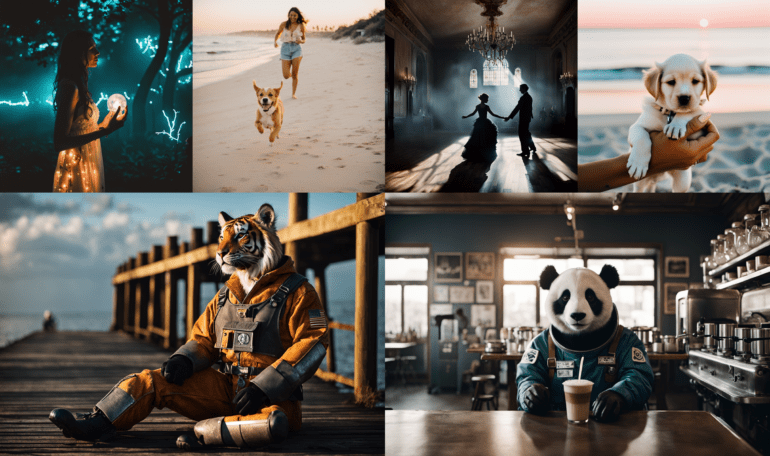TL;DR:
- Stability AI announces Stable Diffusion XL 1.0, its most advanced text-to-image model yet.
- The model offers vibrant colors, improved contrast, and faster image generation with 3.5 billion parameters.
- Stable Diffusion XL 1.0 excels in text generation, supporting inpainting and outpainting features.
- Ethical concerns arise due to potential misuse, but Stability AI takes steps to mitigate harmful content.
- The company collaborates with AWS and introduces fine-tuning capabilities for specialized image generation.
- Stability AI faces stiff competition in the market, but remains committed to innovation and responsible AI usage.
Main AI News:
In the ever-evolving world of AI startups, Stability AI continues to assert its dominance with the introduction of its latest breakthrough: Stable Diffusion XL 1.0. The company’s commitment to pushing the boundaries of generative AI models and addressing ethical challenges sets it apart amidst fierce competition.
Unveiling its “most advanced” release to date, Stability AI proudly presents Stable Diffusion XL 1.0, a powerful text-to-image model that promises to revolutionize the field. Embracing an open-source approach, this cutting-edge technology is now available on GitHub, in addition to Stability’s API and consumer apps, ClipDrop and DreamStudio. The model boasts an array of enhancements, including more vibrant and accurate colors, improved contrast, shadows, and lighting, setting it a notch above its predecessor, Stability’s acclaimed XL 0.9 model.
Head of applied machine learning at Stability AI, Joe Penna, revealed that the Stable Diffusion XL 1.0, armed with a staggering 3.5 billion parameters, can generate full 1-megapixel resolution images in mere seconds, offering flexibility across multiple aspect ratios. These parameters are the key to the model’s prowess, as they define its skill in generating lifelike images from training data.
One of the remarkable aspects of Stable Diffusion XL 1.0 is its exceptional customizability, allowing fine-tuning for concepts and styles. Penna affirms that it offers ease of use and enables complex designs through basic natural language processing prompts. This means that users can unlock a world of creative possibilities with just a few simple commands.
Text generation capabilities receive a significant boost in this latest iteration. While most text-to-image models struggle with creating legible logos, fonts, or calligraphy, Stable Diffusion XL 1.0 shines with its advanced text generation and remarkable legibility. The model’s prowess extends to inpainting, outpainting, and “image-to-image” prompts, where users can input an image and add text prompts to generate intricate variations of the picture. Moreover, the model handles complex, multi-part instructions with ease, a feat that was previously a challenge for Stable Diffusion’s earlier versions.
However, amidst all the breakthroughs, Stability AI acknowledges the moral challenges that come with such powerful technology. The open-source version of Stable Diffusion XL 1.0 holds the potential to be misused by bad actors to generate toxic and harmful content, including nonconsensual deepfakes. This concern is partially rooted in the extensive training data derived from millions of images across the web.
While the company has taken “extra steps” to mitigate harmful content generation by filtering out “unsafe” imagery from the model’s training data and implementing new warnings related to problematic prompts, the potential for misuse remains a point of ethical concern. Furthermore, the model has been trained using artwork from artists who have expressed objections to their work being used without consent in generative AI models. Although Stability AI asserts its compliance with the fair use doctrine in the U.S., legal disputes with artists and entities like Getty Images continue to challenge the company.
Stability AI remains committed to respecting artists’ rights and incorporating their requests to be removed from training data sets. The company emphasizes its dedication to continually improving the safety features of Stable Diffusion XL 1.0 to ensure responsible AI usage.
With the release of Stable Diffusion XL 1.0, Stability AI is also launching a fine-tuning feature in beta for its API, enabling users to specialize image generation with as few as five images, catering to specific individuals, products, and more. This innovation, coupled with its collaboration with Amazon’s cloud platform, Bedrock, further solidifies Stability AI’s position as an industry leader.
As the commercial landscape heats up, Stability AI faces strong competition from industry giants like OpenAI and Midjourney. Despite financial challenges, Stability AI’s relentless pursuit of innovation and commitment to delivering top-tier solutions for the AI community cements its place as a significant player in the field.
CEO Emad Mostaque expresses confidence in Stability AI’s journey, describing the latest SDXL model as a testament to the company’s heritage of innovation and its dedication to providing cutting-edge open-access models. With its eyes set on the future, Stability AI continues to collaborate with AWS to drive progress and excellence for developers and clients alike.
Conclusion:
Stability AI’s release of Stable Diffusion XL 1.0 represents a significant advancement in the field of generative AI models. With enhanced image quality, faster processing, and text generation capabilities, the model opens up new possibilities for creative applications. However, ethical concerns surrounding potential misuse must be carefully addressed to ensure responsible AI usage. The collaboration with AWS and the introduction of fine-tuning capabilities demonstrate Stability AI’s determination to stay at the forefront of the market. Despite the competition, the company’s dedication to innovation and commitment to meeting user needs position it as a strong player in the AI industry.

